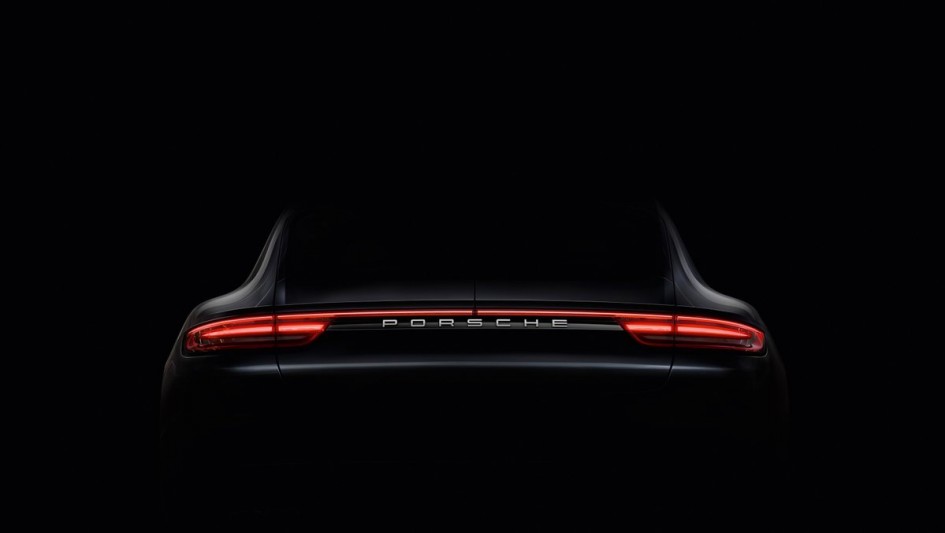Partager la publication "Porsche Panamera se présente en World premiere live 28/06 : 4S & Turbo & 7 min 38 s au Nürb’"
Porsche a choisi ce 28 juin pour présenter la nouvelle Panamera en direct de Berlin, le show commence dès 20h10. Voilà les Porsche Panamera 4S & Turbo se présentent en World premiere live 28/06. Et l’une claque un chrono record de supercar pour une voiture type ‘luxury sedan’ avec un temps de 7 min 38 s au Nürburgring !
Breaking a record. The new Panamera is coming. Trailer
Porsche premiere in Berlin
==> Livestream World Premiere Berlin 2016 Porsche Panamera
The new Panamera makes its first major appearance before the international media in Berlin with a spectacular show of light, music and choreography. You can view the world premiere today starting 8:10 pm (CEST) here via live stream. Want to know more about the new car? Here you go.
Reconciling contradictions – that’s a tradition at Porsche. It takes courage to do things. Not just keeping to the well-trodden path but reinventing yourself time and again. Just as Porsche did seven years ago.
A segment changed. A success story began. And will now be continued. With the courage of a new generation. New standards will be set. Opposites reunited once again. More than ever. Look forward with us to a new four-door sports car.
MAJ 20h30
Après 7 ans d’une belle carrière, la Porsche Panamera première du nom fait place à une toute nouvelle génération de la berline Grand Tourisme. Il y a quelques jours elle se montrait encore camouflée dans la course de côte du Festival of Speed de Goodwood, avec Patrick Dempsey à son volant, c’est à l’occasion d’une grande cérémonie à Berlin que la Panamera 2 vient de révéler au médias et au public !
Patrick Dempsey completes the new Panamera’s development journey
Five years and more than a million miles after it began its engineering journey, the new Panamera, in its final prototype form, has appeared at the Goodwood Festival of Speed in Great Britain, driven by race driver and actor Patrick Dempsey. Courage changes everything. The new Panamera is coming.
Présentation de la Porsche Panamera 2016
Ce mardi, à Berlin, Porsche a dévoilé en première mondiale la nouvelle Panamera dans le cadre d’un grand show lumineux, musical et chorégraphique. Plus de 300 représentants des médias internationaux ainsi que des invités issus du monde politique, des affaires, du sport et de la société civile, ont eu le privilège de découvrir en primeur la deuxième génération de la Gran Turismo de Porsche. Entièrement nouvelle, la Porsche Panamera allie avec un brio inédit deux qualités antagonistes : les performances d’une authentique voiture de sport et le confort d’une berline de luxe.
Porsche Panamera 2016 Live reveal premiere
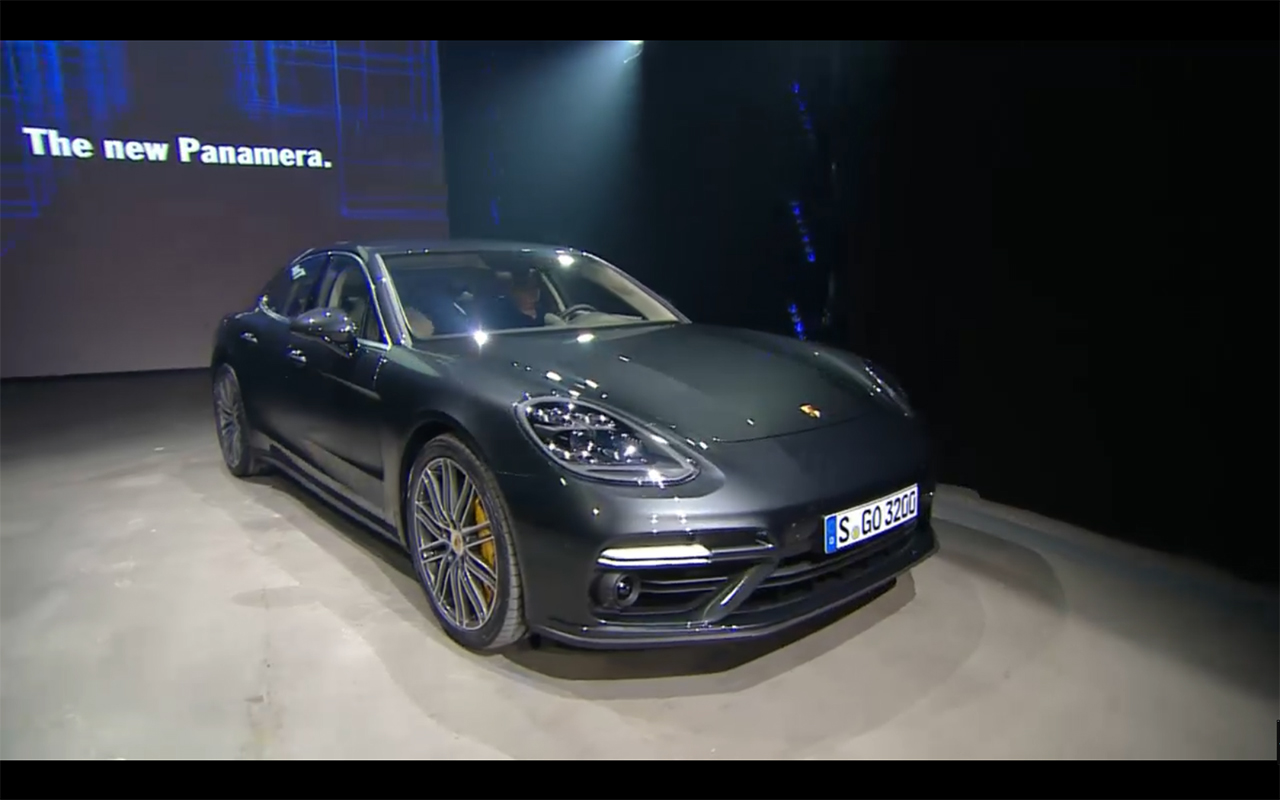
Porsche Panamera – 2016 – front side-face preview
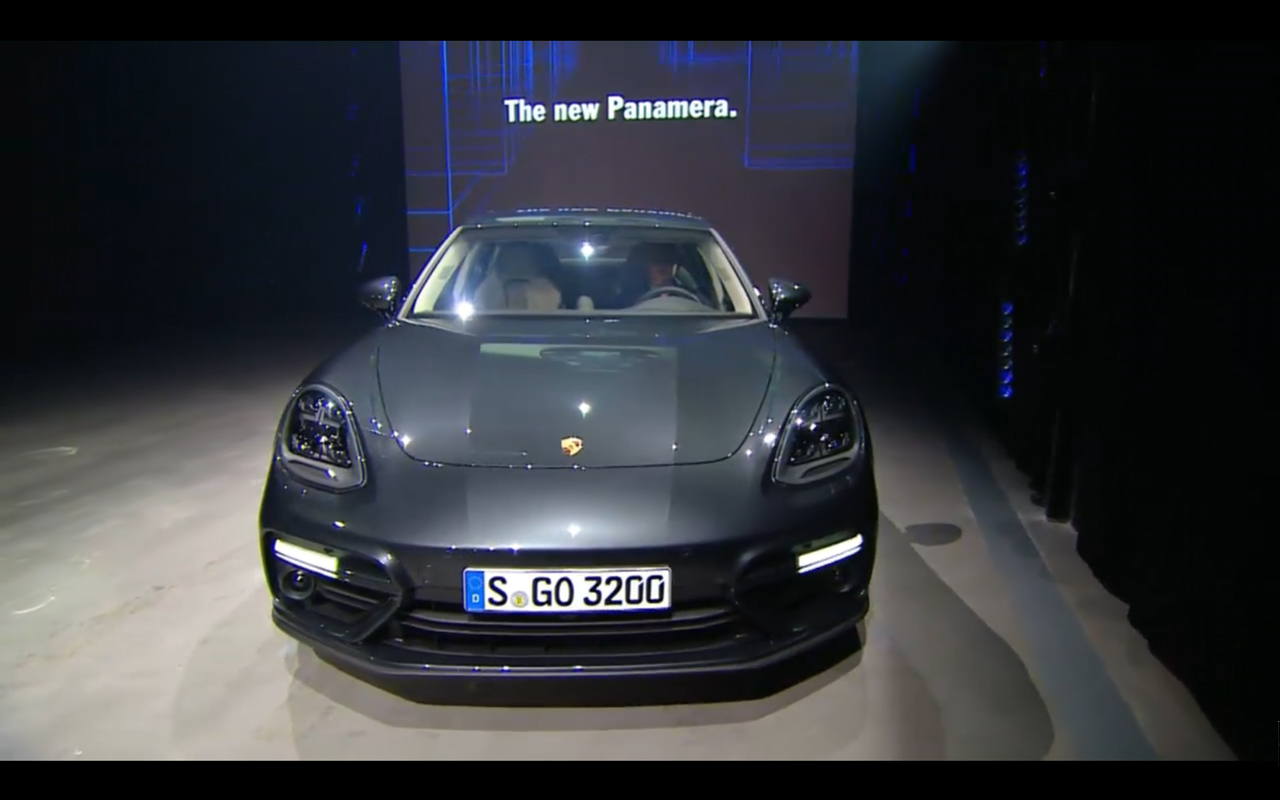
Porsche Panamera – 2016 – front-face preview
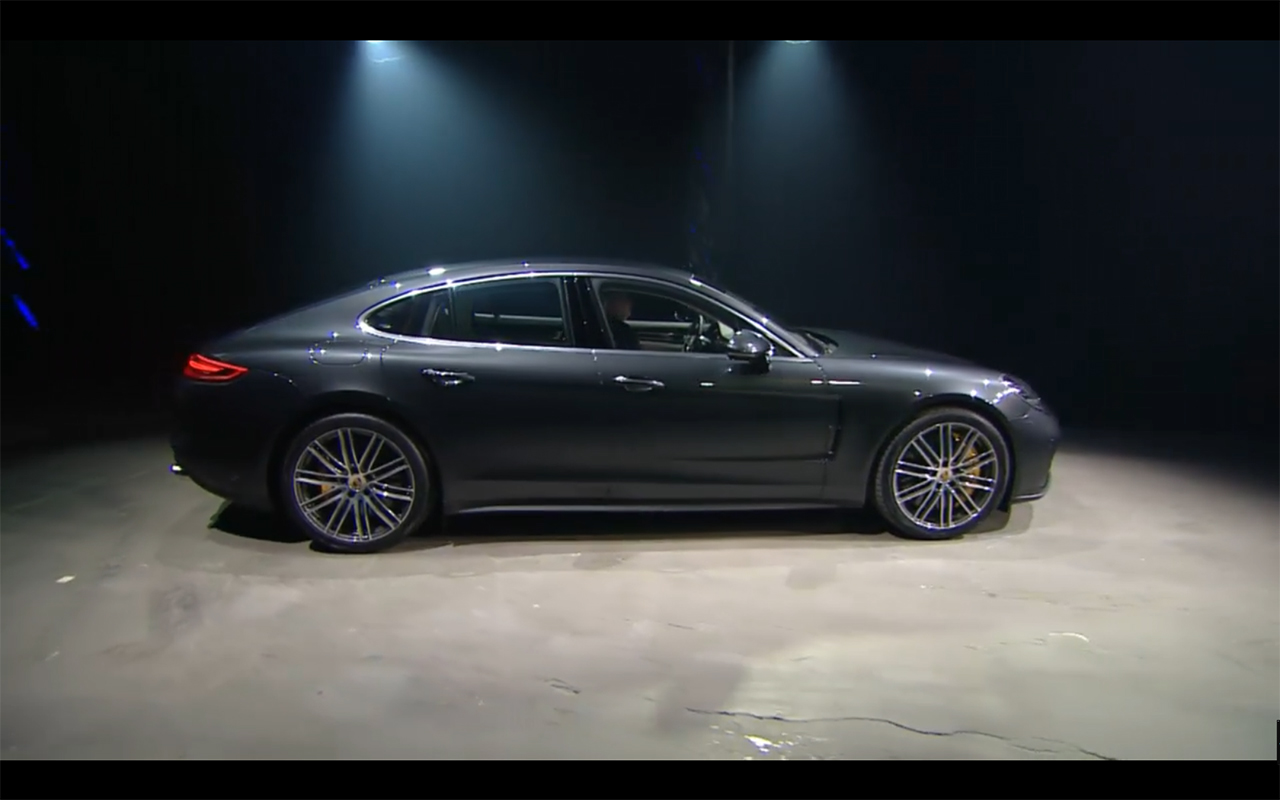
Porsche Panamera – 2016 – side-face preview
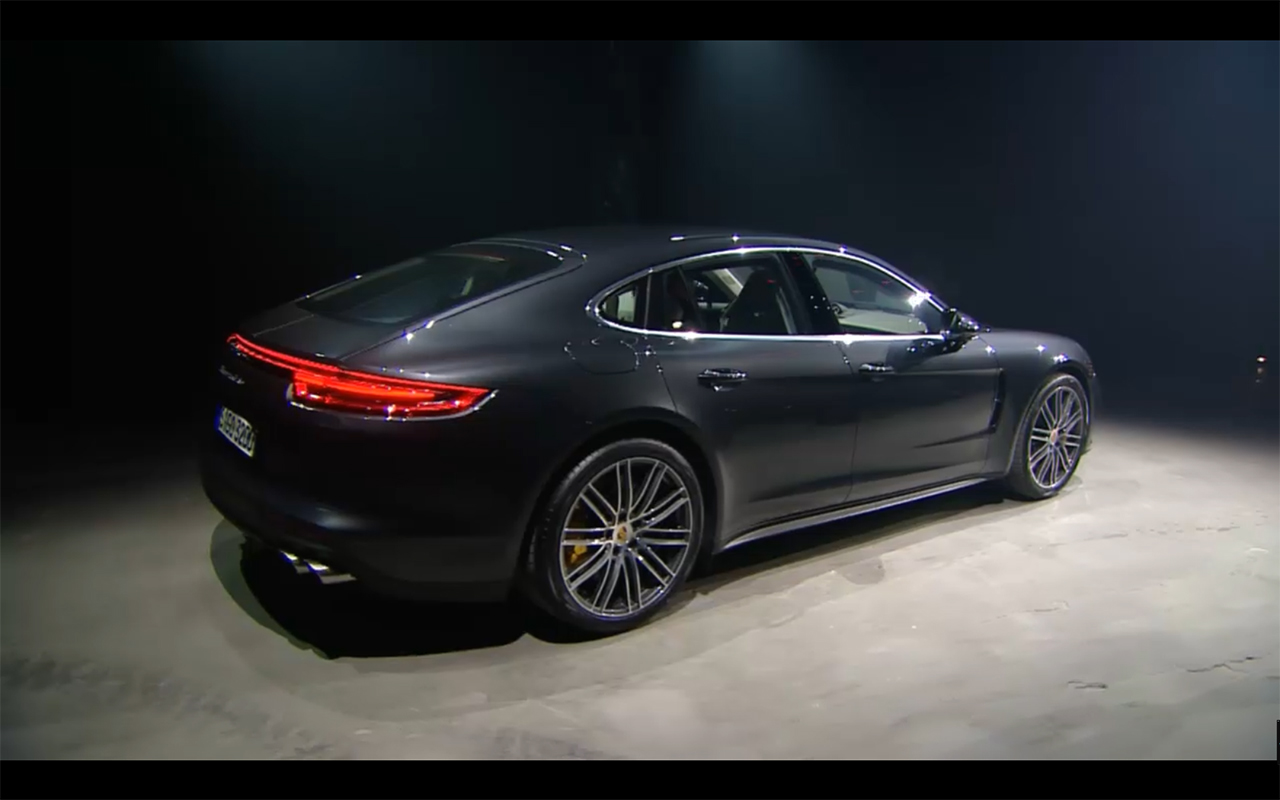
Porsche Panamera – 2016 – rear side-face preview
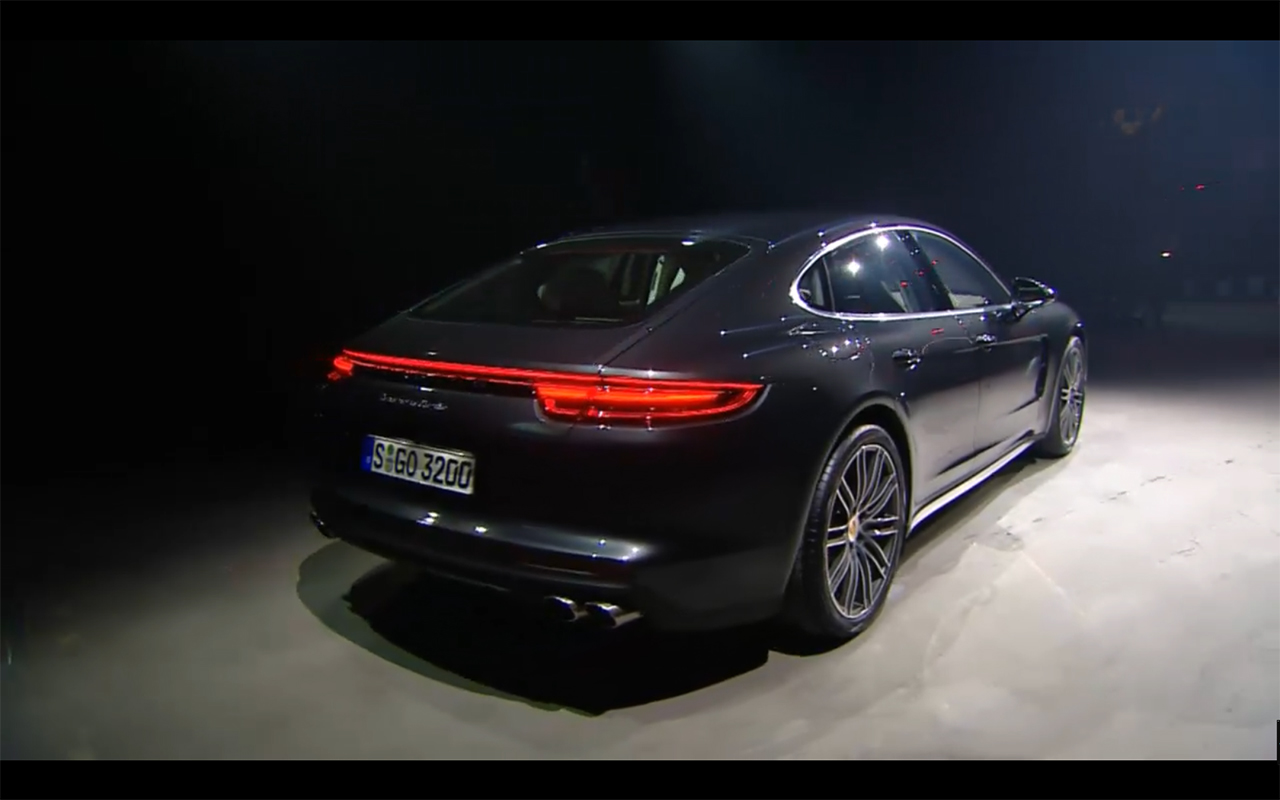
Porsche Panamera – 2016 – rear preview
The new Panamera. Courage changes everything.
How do you create an unmistakeable sedan that was born on the race track and is at home on the road? With the courage to change. The courage to make driving even more intuitive and at the same time more intense. The courage to build a genuine sports car with four business class seats.
Design de la Porsche Panamera 2016
The design of the new Panamera.
The silhouette and proportions of the new Panamera models are more Porsche than ever. Clearly perceived rounded transitions, powerful muscles and a sharpened sports car silhouette emphasise the precision of the new design.
La nouvelle Panamera conserve la ligne générale de la première génération. Maintenant, elle s’inspire très clairement du concept Sport Turismo de 2012, que ce soit pour les nouveaux boucliers, le nouveau regard à 4 points lumineux, ou encore la signature lumineuse horizontale arrière, qui traverse toute l’élégant derrière de l’auto.

Porsche Panamera – 2016 – front light / optique avant

Porsche Panamera – 2016 – rear light / optique arrière
Afin de combiner mieux encore le confort et la sportivité, la nouvelle Panamera dispose également désormais d’une nouvelle suspension pneumatique à trois chambres, d’un essieu arrière directionnel et du nouveau système de gestion électronique du châssis 4D Chassis Control, notamment.

Porsche Panamera – 2016 – wheel / jante
Design extérieur de la Porsche Panamera 2016
Le langage stylistique de la nouvelle Panamera exprime sa filiation avec la Porsche 911 grâce à sa ligne de toit plongeante encore plus dynamique et des éléments de design caractéristiques de l’icône des voitures de sport.
« Nous avons accédé au segment des berlines sportives de luxe avec la Panamera. Depuis son lancement en 2009, plus de 150 000 exemplaires de la Panamera ont été vendues. Cette nouvelle Panamera a fait l’objet d’un nouveau développement complet avec de nouveaux moteurs, un nouveau design et de nouvelles technologies. Autre nouveauté: la deuxième génération de la Panamera est entièrement produite sur notre site de Leipzig. Pour sa production, nous avons également investi 500 millions d’euros, avec notamment une toute nouvelle usine de carrosserie. » - Oliver Blume, Président du Directoire Porsche.

Porsche Panamera – 2016 – front side-face – profil avant – photo Berlin

Porsche Panamera – 2016 – rear light – night photo
« L’observateur identifiera immédiatement la ligne de toit similaire à celle d’un coupé, qui est désormais nettement plus ‘plongeante’ et plus dynamique. Le nouveau design des vitres latérales souligne encore plus sa silhouette de coupé. La nouvelle Panamera peut être identifiée au premier regard comme une Panamera. Mais également comme une nouvelle Panamera. Ses atouts ont été transcendés, ses faiblesses éliminées et, surtout, son caractère préservé. »- Michael Mauer, Responsable du Style Porsche
Design intérieur de la Porsche Panamera 2016
Sur la nouvelle Panamera, Porsche introduit encore un concept de commandes et d’affichage orienté vers l’avenir. Avec ses interfaces utilisateur inspirées des smartphones et ses écrans à LED à configurations multiples, le nouveau Porsche Advanced Cockpit brille par sa fonctionnalité intuitive. Par ailleurs, le nouveau système Porsche Communication Management (PCM 4.1) ouvre la voie à une connectivité inédite aves ses fonctions digitales intelligentes et ses services en ligne.
Avec la nouvelle Panamera, que les clients peuvent d’ores et déjà commander, le système Porsche Connect est introduit sur tous les modèles. Ce système développe les fonctions du véhicule avec de nouveaux services et applications, par exemple pour la commande à distance de certaines fonctions du véhicule à l’aide d’un smartphone, et d’autres fonctionnalités permettant de mettre plus efficacement à profit le temps passé en voiture.
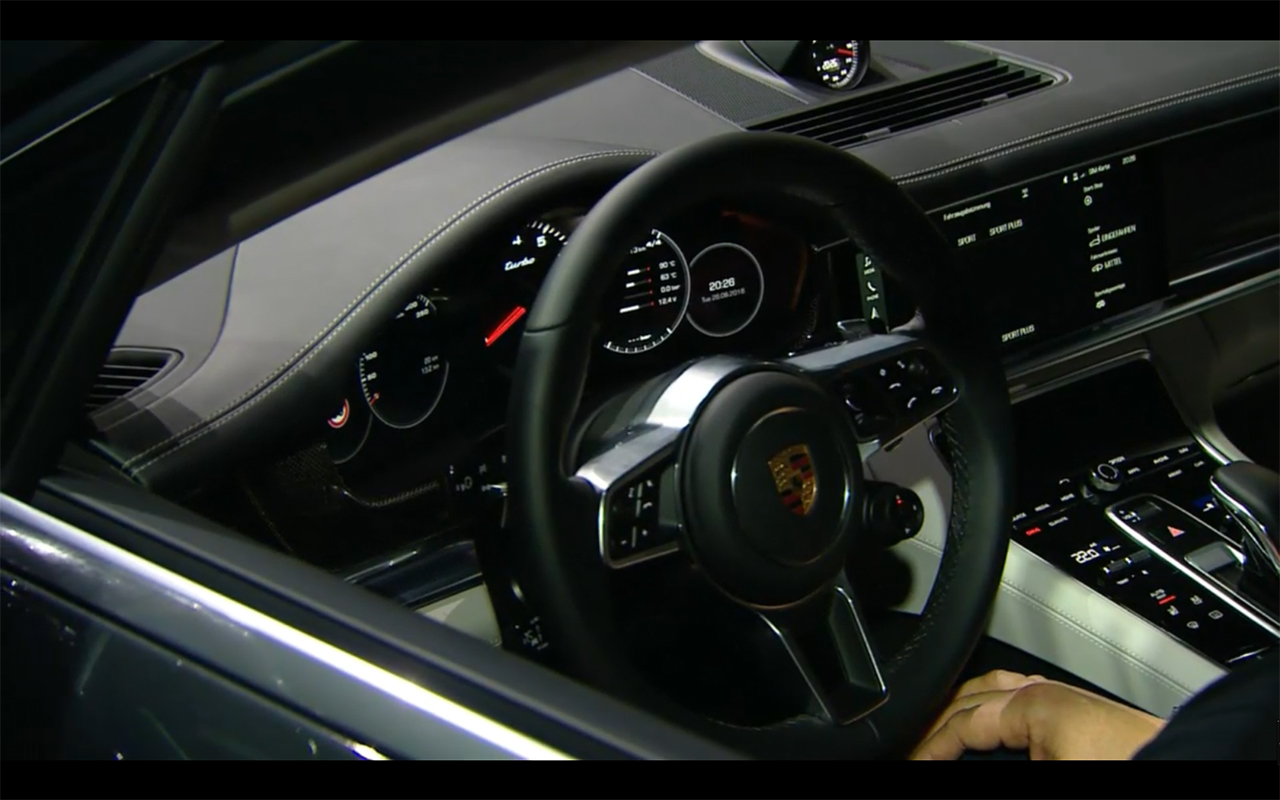
Porsche Panamera – 2016 – interior preview
On trouve des surfaces tactiles sur la console centrale, tandis que le grand écran central de 12,3 pouces, tactile, regroupe désormais l’ensemble des fonctions de l’auto. Deux autres écrans de 7 pouces sont logés face au conducteur, dans le combiné d’instrumentation, tout ça via ‘Advanced Cockpit’.
The new Panamera Turbo and Panamera 4S in motion.
A genuine sports car with the comfort of a luxury sedan, without any compromises in everyday life. For sporty drivers – and their sporty passengers. See the first driving scenes of the new Panamera Turbo and Panamera 4S in this video.
Moteur de la Porsche Panamera 2016
Ce qui se passe sous le capot ? Porsche propose trois motorisations biturbo injection directe, V6 et V8, essence et diesel. Pour sa présentation, la Panamera se présente en version 4S, en 4S Diesel et en Turbo.

Porsche Panamera – 2016 – moteur / engine – V8
,Mit seinen 404 kW (550 PS) leistet der neue 4,0-Liter-V8-Biturbo-Motor mit TwinScroll-Ladern, VarioCam Plus und adaptiver Zylindersteuerung 22 kW (30 PS) mehr als bisher – bei weniger Verbrauch. Das maximale Drehmoment von 770 Nm wird zwischen 1.960 und 4.500 1/min erreicht. Der Sprint von 0 auf 100 km/h dauert nur 3,8 s. Höchstgeschwindigkeit: 306 km/h.’
Début novembre, la nouvelle Panamera sera lancée sur le marché avec trois motorisations différentes et exclusivement avec une transmission intégrale : Panamera Turbo (550ch), Panamera 4S (440ch) et Panamera 4S Diesel (422ch).
La version Turbo est équipée du nouveau bloc 4,0 litres avec turbocompresseur développant 550 chevaux, de quoi aligner un chrono au Nürburgring Nordschleife, avec ses 4 roues motrices et directrices, ainsi qu’une suspension pneumatique spécifique.
Breaking a record with the fastest luxury sedan on earth. The new Panamera Turbo.
Ladies and Gentlemen, we’re pleased to present you the fastest luxury sedan on earth.
7 minutes 38 seconds at the Nürburgring. Watch how the record was performed in this video.
La Panamera Turbo avec son V8 4.0L biturbo de 550 chevaux et 770 Nm. Plus puissante de 30 ch que la première Panamera, elle court le 0 à 100 km/h en 3,8 secondes (3,6 s avec Sport Chrono Package), pour une vitesse de pointe de 306 km/h !
Le modèle de base proposera le V6 3,0 litres biturbo 330 chevaux, la version S portant la cavalerie à 450 ch.
Le Diesel, sera toujours là, avec cette fois-ci deux versions, une V6 3,0 litres biturbo de 300 ch et une ‘S’ au V8 donc un 8 cylindres diesel… via l’Audi SQ7 !
Une Panamera 4S Diesel qui développe 422 chevaux et 850 Nm. Avec un 0 à 100 km/h avalé en 4,5 secondes (4,3 en Sport Chrono Package), il s’agit selon Porsche du diesel de série le plus rapide du monde.
En essence, la Panamera 4S opte pour le V6 2.9L biturbo qui développe 440 chevaux, soit 20 ch de plus qu’auparavant. Là aussi, comme son nom l’indique, en 4 roues motrices, cette Panamera atteint 100 km/h en 4,4 secondes (4,2 sec avec le Sport Chrono Package).
Si toutes les versions auront le droit à une boîte automatique 8 rapports, seules les ‘S’ et ‘Diesel’ bénéficieront des 4 roues motrices.
Ultérieurement, une version hybride rechargeable et une 100% électrique – piochant sur le prototype Mission E – étofferont la gamme Panamera.
English summary
New Porsche Panamera : The sports car among luxury saloons
The second generation of the Panamera is advancing to become a performance icon of the luxury class. In this transformation, Porsche has systematically improved the Panamera concept – with a four-door car that has been redeveloped and redesigned down to the last detail. Its engines and transmissions have been redesigned, its chassis perfected, and its display and control concept reinterpreted for the future. The new Panamera also extends the borders between the world of ambitious sports cars and the world of comfortable cruising cars with highlights such as rear axle steering, active roll compensation and three-chamber air suspension.
911 design language with a much more dynamic flyline
Visually, the unique concept of this large Porsche is reflected in a new expressive design: unmistakably a Panamera, unmistakably a sports car – with long, dynamic proportions, pronounced shoulders, athletic flanks and an extremely fast roof line that is 20 mm lower at the rear. This typical Porsche flyline creates a stylistic link to Porsche’s design icon, the 911.
Porsche Advanced Cockpit
The typical Porsche interior has been reinterpreted for the future in the new Panamera. Black panel surfaces and interactive displays combine a clear and intuitive user interface like that of smartphones and tablets with the practical requirements for controlling the car. Classic hard keys and conventional instruments have been reduced significantly. They have been replaced by touch-sensitive panels and individually configurable displays which take centre stage in the new Porsche Advanced Cockpit – with great benefits for the driver as well as the front and rear passengers.
Despite a significantly extended range of communication, convenience and assistance systems, different functions can now be used and operated more clearly and intuitively. The Porsche Advanced Cockpit transforms the analogue world into the digital present of mobility, while leaving room for passion. The tachometer, positioned centrally in the instrument cluster, is a tribute to the 1955 Porsche 356 A.
A luxury saloon that can take to the race track
In keeping with the overall concept of the new Panamera, the chassis also unites the cruising comfort of a luxury saloon with the performance of a true sports car. This is achieved by supplementing the impressive basic layout with optional innovative systems such as an adaptive air suspension with new three-chamber technology, including Porsche Active Suspension Management (PASM electronic damper control), the enhanced Porsche Dynamic Chassis Control Sport system including Porsche Torque Vectoring Plus and active roll stabilisation, as well as a new electromechanical steering system.
The integrated 4D Chassis Control system analyses and synchronises all chassis systems in real time and optimises the road performance of the new Panamera. Porsche is also taking the steering precision and handling of sports cars into the class of Gran Turismo cars with rear axle steering – which is also new and has been adapted from the 918 Spyder and 911 Turbo. Brake performance has also been improved.
The Panamera is equipped with many standard and optional assistance systems, which make life while driving more convenient and safer. The most important new systems include a night vision assistant, which uses a thermal imaging camera to detect people and large animals and displays a colour highlighted warning indicator in the cockpit. If the optional new LED matrix headlights with 84 image points are selected, people beyond the visual range of the dipped beam headlight are also illuminated briefly if they are in the computed driving corridor, allowing the driver to react even faster.
Details of the new design: even more dynamic proportions

Porsche Panamera – 2016 – sketch
The exterior character of the Panamera has also been sharpened with the dawn of the second generation. It is based on very dynamic proportions. The new Panamera is 5,049 mm (+34 mm) long, 1,937 mm (+6 mm) wide and 1,423 mm (+5 mm) tall. Despite the slight increase in height, the four-door car looks much lower and longer. This is primarily due to the reduced height above the rear of the passenger compartment – reduced by 20 mm – while maintaining consistently good headroom. This changes the car’s overall image completely.
The wheelbase has been increased by 30 mm to 2,950 mm; this too lengthens the car’s proportions. The front wheels were shifted further forward, reducing the front overhang and making the prestige dimension – the distance between the A-pillar and the front axle – even larger. The rear overhang is longer, giving the car a more powerful appearance.
The Panamera has only grown six millimetres in width, but it feels like several centimetres. This effect is created by such features as the A-shaped air intake, which extends out to the sides and creates a completely new front-end design. At the same time, a precisely designed crossbar in the radiator grille emphasises the car’s width. The arrow-shaped bonnet over the engine accelerates this visual effect further forward and lower than before – due to the prominently contoured powerdome, whose lines now reach into the bumper.
The lower front end was enabled by the new compact construction of the engines in the vehicle concept. To the left and right of the powerdome, the bonnet blends precisely into the stronger flares of the front wings – a typical Porsche design trait. Also exuding confidence is the look of the LED headlights with their four-point LED daytime running lights, of which three versions are available.
Three-dimensionality characterises the doors and wings
The new side body – like the bonnet, boot, roof and wings – is made entirely of aluminium, and it accentuates the silhouette of a sports car more than ever thanks to its dynamic roof line. At the rear, this roof line becomes the charismatic Porsche flyline – the distinctive lines that adorn all of the brand’s coupés. Two precisely executed edges on the lateral roof line visually lower the silhouette’s centre of gravity. The look of the side windows has also been redesigned: its visually continuous surface, together with its lines on the rear body, creates a stylistic affinity to the Porsche 911.
Three-dimensionality characterises the doors and wings, where incident light shining on their convex and concave surfaces generates muscular tension. Integral design components there are the air exhaust ports behind the front wheels. The flared lips of the wheel arches are also powerful. The large arches provide space for the 19-inch (4S/4S Diesel), 20-inch (Turbo) and optional 21-inch alloy wheels.
The fact that the Panamera is a four-door coupé and not a conventional saloon is clearer from the rear than from any other perspective. The ‘greenhouse’ – made up of the roof, roof pillars, window surfaces – is supported by a powerful and broad shoulder section. Clearly a Panamera, definitely a sports car. The most prominent components identifying the rear body are, without a doubt, the three-dimensional LED rear lights with integrated four-point brake lights. The rear lights are interconnected by a narrow LED strip.
All of these elements together create an unmistakable night design. Integrated seamlessly and elegantly into the boot, which features electric opening and closing as standard, is the extendible rear spoiler that is now finished in body colour. On the Panamera Turbo, the wing also splits as it extends, thereby gaining additional surface area. Terminating the lower rear body is a diffuser into which the dual stainless steel tailpipes of the exhaust system are integrated on the left and right. The Panamera 4S and 4S Diesel can be recognised by their round tailpipes, while the Panamera Turbo has trapezoidal tailpipe trims.
Porsche operating philosophy – future-based interpretation
The new Panamera exhibits a completely new interior design. In many areas, touch-sensitive surfaces replace classic hard keys, and high-resolution displays merge into the interior. In the luxury saloon segment, the digitalisation of the Porsche interior, which began with the 918 Spyder, has reached the next development stage aboard the Panamera in the form of the new Porsche Advanced Cockpit. From the low seat position typical of sports cars, drivers not only see a fascinating front-end landscape of the car’s wings and powerdome, but also two 7-inch displays that are placed directly in the driver’s line of sight for ideal ergonomics. Located in the middle of these two displays is the tachometer, which is still an analogue instrument.
Meanwhile, the gearshift console between the driver and the front passenger is dominated by the 12.3-inch touchscreen of the next generation Porsche Communication Management (PCM) system. The driver and front passenger can configure this display individually. Naturally, this is integrated into the PCM: Features such as online navigation, the online functions of Porsche Connect, smartphone integration via Apple Car Play and a new voice control system that responds to natural language input.
The PCM area – with its high-end, high-resolution display – transitions harmoniously into the black panel concept of the centre console with a shift-by-wire gear selector for the PDK. A new control panel with touch-sensitive switches on the centre console enables intuitive control of various functions. Even the louvres of the central air vent are electrically adjusted by touch-sensitive sliders. Rear passengers can control air conditioning and infotainment functions using an optional four-zone automatic climate control system.
In addition, the Porsche Panamera offers the best layout variability of any model in the luxury class, making it the most practical for everyday use with a 40:20:40 split of the folding rear bench backrests (495 to 1,304 litres of luggage capacity). Raising the comfort experience of the Panamera to an entirely new level are new equipment options such as the panoramic tilt roof, massage seats, ambient lighting and a 3D high-end sound system from Burmester.
New V6 and V8 biturbo engines with ample power and full-bodied sound
A Porsche has always impressed with more than just power; its efficiency is equally important. To elevate this formula to a new level, all of the second generation Panamera’s engines have been redesigned. They have all been made more powerful, while significantly improving fuel economy and reducing emissions.
Three new biturbo direct injection engines are being introduced at the market launch: in the Panamera Turbo, the Panamera 4S and the Panamera 4S Diesel.
All of them – and for the first time including the diesel – may be equipped with a permanent all-wheel drive system and a new eight-speed Porsche dual-clutch transmission (PDK for Porsche Doppelkupplung).
A V8 petrol engine that delivers 550 hp powers the Panamera Turbo and a V6 petrol engine with 440 hp drives the Panamera 4S. In the Panamera 4S Diesel, a V8 with 422 hp generates powerful thrust and a maximum torque of 850 Nm.
Porsche Doppelkupplung

Porsche Doppelkupplungsgetriebe
,Mehr Kraft aus den Motoren ist nur sinnvoll, wenn man weiß wohin damit. Und zwar schnell und effektiv. Die neuen Panamera Modelle verfügen deshalb über ein neuentwickeltes 8-Gang Porsche Doppelkupplungsgetriebe (PDK), das die enorme Kraft der Motoren in sportwagenadäquate Beschleunigung umsetzt.
Die Gänge 1 bis 6 sind sportlich ausgelegt, die Höchstgeschwindigkeit wird im 6. Gang erreicht. Der 7. und 8. Gang sind lang übersetzt und sorgen für niedrige Drehzahlen, auch bei höheren Geschwindigkeiten – für effiziente und komfortable Langstreckenfahrten. Die präzisen Gangwechsel erfolgen in Millisekunden ohne spürbare Zugkraftunterbrechung – wie es sich für einen Sportwagen gehört.’
New engines in detail: more power, better fuel efficiency
New, powerful and fuel-efficient: the V6 and V8 turbo engines of the Panamera. And they all share a special conceptual design characteristic, which in the jargon of engine developers is known as ‘with the hot sides inward’. Translated, this means that the turbochargers of the new Panamera engines are integrated centrally into the V of the cylinder banks. This central turbo layout yields numerous benefits: The engines are more compact, and this enables a lower mounting position. This, in turn, has a positive effect on the vehicle’s centre of gravity.
The short paths between the two turbochargers and the combustion chambers produce spontaneous throttle response. Engine response can be further increased using the optional Mode Switch with the Sport Response Button. The Mode Switch, which was first introduced in the Porsche 918 Spyder, is an intuitively operated rotary ring on the steering wheel, which can be used to activate one of four driving modes (Normal, Sport, Sport Plus or Individual). Located at the centre of the switch is the Sport Response Button. It can be used to free up the maximum power potential of the Panamera at the press of a button.
Porsche uses complex twin-scroll turbochargers
Initially, the Panamera Turbo has the most powerful petrol engine of the model series. Its 4.0-litre biturbo V8 develops 550 hp (at 5,750 rpm) and a maximum torque of 770 Nm (between 1,960 and 4,500 rpm). It has 30 hp more power than the previous model, and its maximum torque has been increased by 70 Nm. The eight-cylinder engine accelerates the Panamera Turbo to 100 km/h in 3.8 seconds; with the Sport Chrono Package the sprint time is just 3.6 seconds. The Porsche can reach a top speed of 306 km/h.
These are impressive figures that illustrate just how easily the engine can propel the Panamera with its power-to-weight ratio of just 3.6 kg/hp. These extraordinary performance figures contrast with lower combined fuel consumption.
Porsche uses complex twin-scroll turbochargers to supply compressed air to the V8’s combustion chambers. The two counter-rotating chargers produce maximum torque figures at very low engine speeds. The Panamera Turbo is also the first Porsche to be equipped with the new adaptive cylinder control in its engine. In part-load operation, the system temporarily and imperceptibly turns the eight-cylinder into a four-cylinder engine. This reduces fuel consumption by up to 30 per cent, depending on power demand in the four-cylinder phases.
The 2.9-litre V6 biturbo engine of the Panamera 4S develops a maximum power of 440 hp (20 hp more than the previous model); it is already available at 5,650 rpm, which is just above the nominal engine speed. Between 1,750 and 5,500 rpm, the new six-cylinder delivers 550 Nm (30 Nm more) to the drive axles.
The Panamera 4S can reach 100 km/h in just 4.4 seconds (4.2 seconds with the Sport Chrono Package). With a top speed of 289 km/h, this Porsche also approaches the 300 km/h mark.
Like the eight-cylinder engine of the Panamera Turbo, the six-cylinder engine of the Panamera 4S also has petrol direct-injection injectors that are positioned in the combustion chamber. This injector position offers optimal combustion, maximum efficiency and very good engine response. The 4S and Turbo are also characterised by exceptionally full-bodied and authentic sound.
The new Panamera is launching with a new eight-cylinder diesel engine, for the first time in conjunction with permanent all-wheel drive. The most powerful diesel implemented in a Porsche production car to date develops a power of 422 hp (at 3,500 rpm) and an immense maximum torque of 850 Nm – which is constant over an engine speed plateau extending from 1,000 to 3,250 rpm.
With a top speed of 285 km/h, the Porsche Panamera 4S Diesel is currently the world’s fastest production vehicle with a diesel engine. The Gran Turismo reaches the 100 km/h speed mark in 4.5 seconds (4.3 seconds with the Sport Chrono Package).
The diesel model also has biturbo charging with a central turbo layout. However, its common rail engine (2,500 bar maximum injection pressure) is equipped with sequential turbocharging. This allows the engine to work as a biturbo or monoturbo, depending on the operating state. At low to moderate engine speeds, the entire stream of exhaust gas is directed solely through one of the two turbochargers, which improves throttle response. The otherwise passive second turbocharger does not become active until the engine speed reaches 2,700 rpm or more. Both turbochargers have variable turbine geometry (VTG) – a principle that is already familiar from the 911 Turbo.
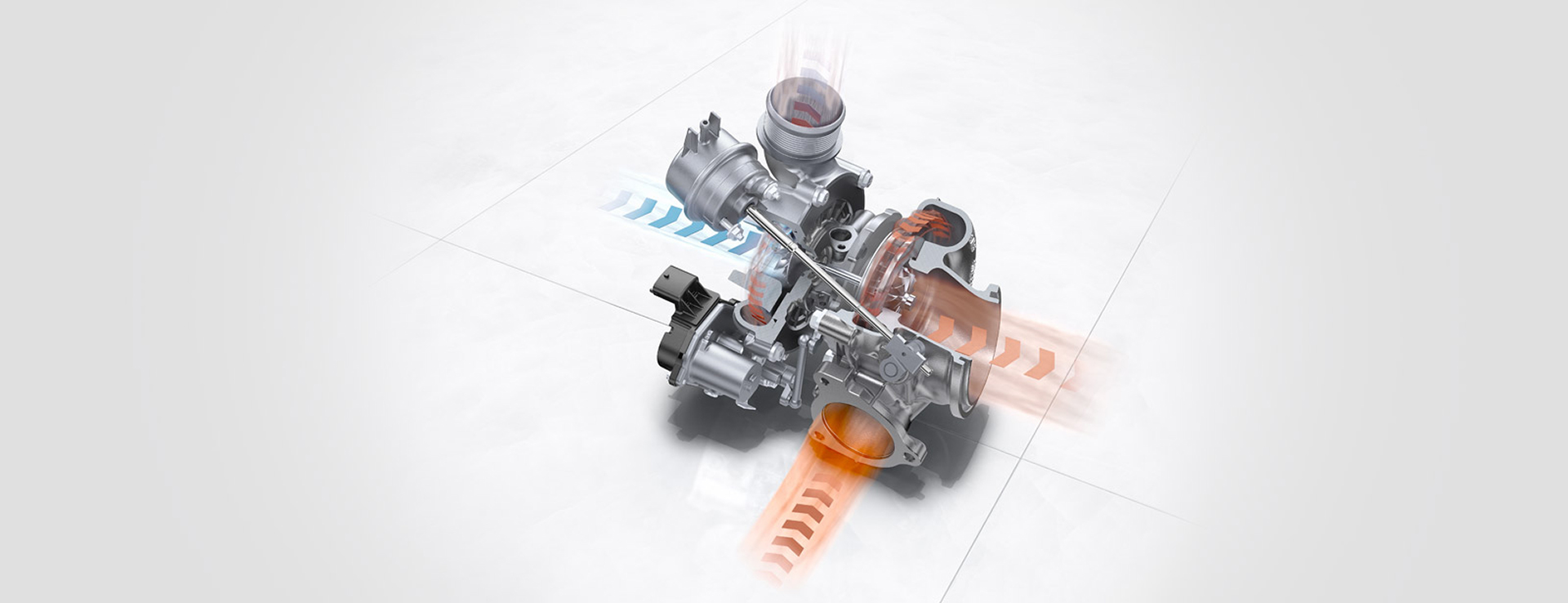
Porsche Variable Turbine Geometry
Source et images :
Porsche
Thanks GOMEX for the link of livestream
Partager la publication "Porsche Panamera se présente en World premiere live 28/06 : 4S & Turbo & 7 min 38 s au Nürb’"

